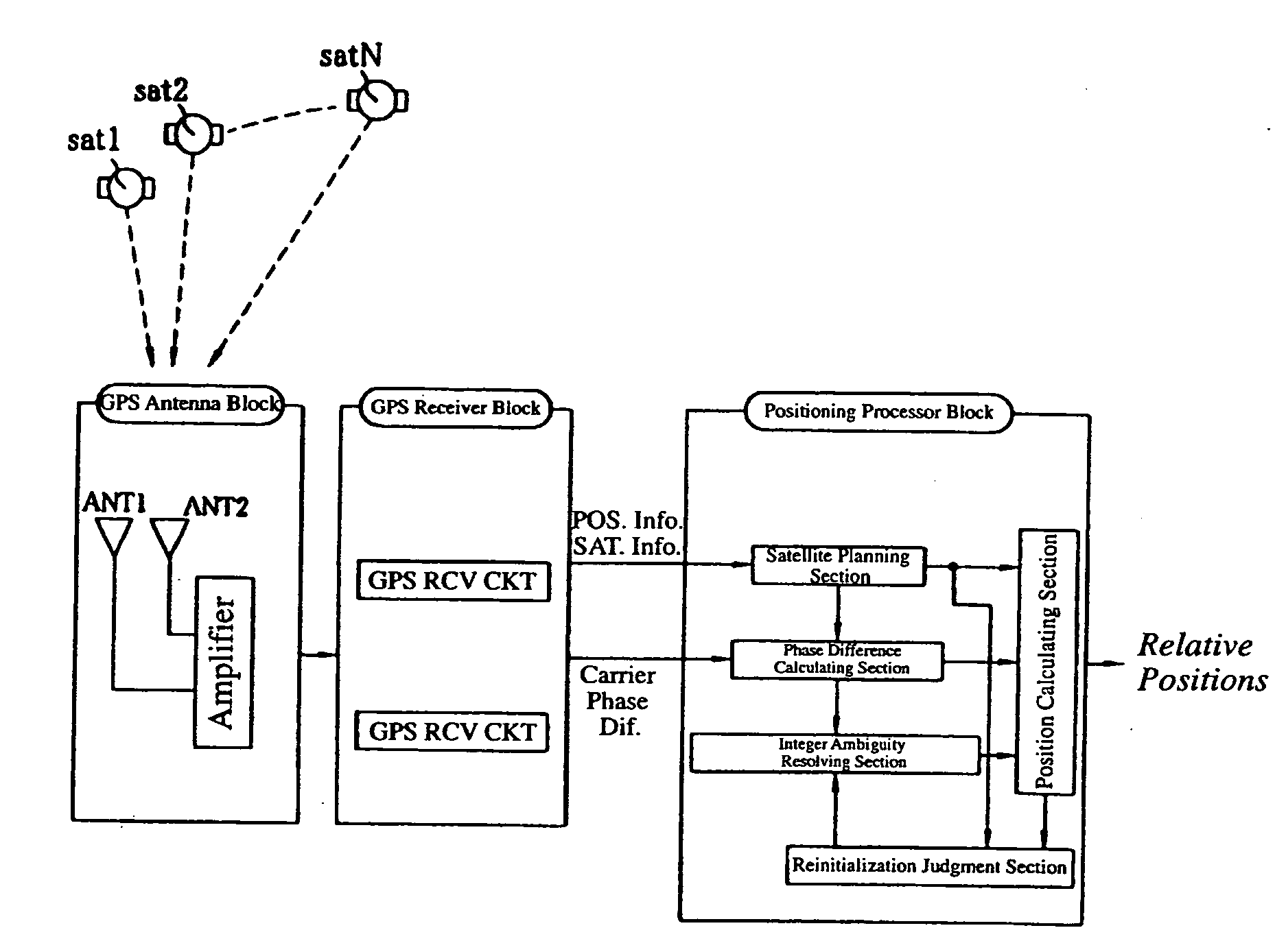Carrier-phase-based relative positioning device
a relative positioning and carrier technology, applied in measurement devices, satellite radio beaconing, instruments, etc., can solve the problems of waste of already accumulated data, inability to directly measure the integral part of the phase difference, and inability to receive the radio waves transmitted from the gps satellite with the antenna, etc., and achieve the effect of quick determination and eas
- Summary
- Abstract
- Description
- Claims
- Application Information
AI Technical Summary
Benefits of technology
Problems solved by technology
Method used
Image
Examples
first embodiment
[0030] First, a carrier-phase-based relative positioning device according to the invention is described with reference to FIGS. 1 to 3.
[0031] FIG. 1 is a block diagram of the carrier-phase-based relative positioning device of the first embodiment, in which designated by the symbols sat1, sat2 and satN are GPS satellites (positioning satellites).
[0032] A GPS receiver block including two antennas ANT1, ANT2 receives radio waves transmitted from the GPS satellites sat1, sat2, satN, downconverts received signals into intermediate frequency (IF) signals. The IF signals are amplified by an amplifier built in the GPS receiver block and delivered to a GPS receiver block.
[0033] Based on the signals received by the individual antennas ANT1, ANT2, the GPS receiver block calculates the positions of the antennas ANT1, ANT2 and carrier phase differences, and sends these data together with information on the individual GPS satellites sat1, sat2, satN to a positioning processor block at specific ti...
second embodiment
[0102] Next, the configuration of a carrier-phase-based relative positioning device according to the invention is described.
[0103] (1) When the number of positioning satellites increases
[0104] In this case, floating ambiguities and baseline vectors are estimated using the same method as in the first embodiment.
[0105] (2) When the number of positioning satellites decreases
[0106] In this case, the filter equation is expressed as follows: 11 [ b k + 1 a k + 1 ] =[I O OT 1 ] [ b k a k ] + [ w bk w ak ] ( 20 )
[0107] where T.sub.1 is a matrix obtained by multiplying a row of a unit matrix I corresponding to a positioning satellite which has become unobservable by 0. As an example, when one (corresponding to the third row) of 12 positioning satellites which could be observed becomes unobservable, the matrix T.sub.1 is expressed as follows, wherein every element of the third row of the unit matrix is multiplied by 0. 12 T 1 = [1 0 0 0 0 0 0 0 0 0 0 0 0 1 0 0 0 0 0 0 0 0 0 0 0 0 0 0 0 0 0 0 ...
third embodiment
[0120] Next, the configuration of a carrier-phase-based relative positioning device according to the invention is described.
[0121] While the aforementioned first and second embodiments employ the Kalman filter for estimating only the baseline vector b.sub.k and the floating ambiguity a.sub.k, the third embodiment employs a Kalman filter capable of estimating not only the baseline vector b.sub.k and the floating ambiguity a.sub.k but also a multipath error v.sub.k, which is observation noise, at the same time.
[0122] In this case, the filter equation representing time update is expressed as follows:
[0123] (1) When there is no change in the satellite information 15 [ b k + 1 a k + 1 v k + 1 ] = [ B k + 1 +O B k + 1 + O I O O O ( 1 -) I ][ b k a k v k ] + [ B k + 1 +( y k + 1 - y k ) o o] + [ w bk w ak w vk ] ( 27 )
[0124] where B.sub.k+1.sup.+=(B.sub.k+1.sup.tB.sub.k+1).sup.-1B.sub.k+1.su-p.t and .alpha. is a constant representing a property of multipath errors.
[0125] Mathematical opera...
PUM
 Login to View More
Login to View More Abstract
Description
Claims
Application Information
 Login to View More
Login to View More - R&D
- Intellectual Property
- Life Sciences
- Materials
- Tech Scout
- Unparalleled Data Quality
- Higher Quality Content
- 60% Fewer Hallucinations
Browse by: Latest US Patents, China's latest patents, Technical Efficacy Thesaurus, Application Domain, Technology Topic, Popular Technical Reports.
© 2025 PatSnap. All rights reserved.Legal|Privacy policy|Modern Slavery Act Transparency Statement|Sitemap|About US| Contact US: help@patsnap.com



